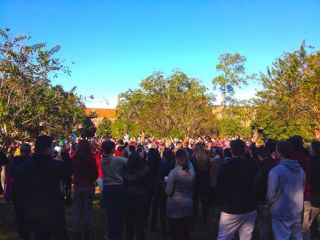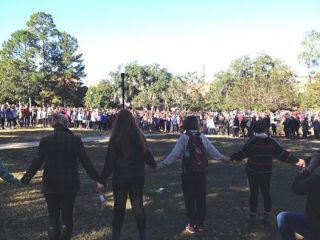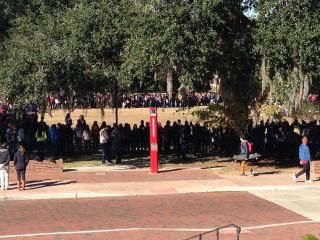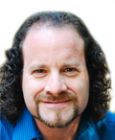
Fear
It Came Home: My Personal Response to the FSU Shooting
As an FSU professor, my response to the campus shooting on Nov. 20, 2014
Posted November 24, 2014

This post is not about prison; it’s not about forensics; it’s not even about art therapy. It’s about what happened at Strozier Library at Florida State University on Thursday, November 20th 2014.
I’m writing about this because, well… I am simply taking advantage of this venue, my blog, to vent my feelings of frustration, vulnerability, fear and dis-ease. You see, I am a professor, and Department Chairperson here at the Florida State University.
In case you are not aware of what happened, around 12:30am Thursday morning, a man with a handgun opened fire in the lobby of the library, grazing one student, hitting two- one multiple times. Two of the students were hospitalized, with one remaining in critical condition. Another student running from the scene was also hit, protected by his books in his backpack. He was not aware he was targeted until he got home and discovered the bullet in his bag.
Several minutes later, the city and campus police arrived at the scene, and when the gunman opened fire at them from the outside steps of the library, they returned fire, killing him instantly.
Upon hearing about this early Thursday morning, I rushed to campus to see what I could do to help. You can imagine that there was very little I could do. After canceling classes, checking in with the faculty and accounting for all of our students, it was a matter of waiting around to hear as more news trickled in. We knew very little.
The library sits on Landis Green, a large expanse of lawn surrounded on all sides by various buildings, with a fountain in the center. My building sits on this Green, and my office overlooks it. The library is clearly visible from my window. Yellow “Do Not Cross” tape surrounded the steps leading to the Library entrance, with one large window broken caused by one of the bullets that went through it. Police cars surrounded the Green, most with lights flashing.


On the Green
Around 10:00, I could see students and the media begin to amass on the lawn. I went out and joined them. The students stood around in large groups around the fountain, several praying, many hugging each other with dazed expressions. They then created a large circle; they spontaneously broke into the Seminoles chop and war chant. This went on for around 10 minutes. Say what you want about the ‘Noles, this chant and chop created a sense of solidarity. The chant slowly wound down; in the silence a single woman’s voice loudly and enchantingly sang the School Song. She was near me, but I probably could have heard it across the Green--it was so clear and hypnotic.

View from my window
I did what any art therapist would do. I took pictures. Shortly after that, I came inside; the circle remained intact for 15 more minutes before the crowd slowly dissipated. As I began to post the images and videos on Facebook to keep people informed while giving a sense of place, messages began to trickle in. All voiced outrage about this atrocity and concern and fear for me, the faculty and our students---some wanted details that I could not give. I could only reassure that we were fine. Throughout the day I met with the few students and faculty who were on campus.
Facebook posts and messages came from rival institutions and states, voicing that today “We are FSU” with the requisite hash tag; these were similar messages that we had sent when it occurred on other campuses—but now it was us.
My colleagues and I in the art therapy program received emails from our colleagues from programs all across the country, giving us support and compassion. It was overwhelming and much-needed.
Of course, shortly after the incident, politics broke out—black and white perspectives on gun control and the NRA began to circulate; everyone from the Governor and the conservatives to Obama and the liberals were to blame for what happened. I must confess, even I was drawn into the discussion after Andy Borowitz, from the New Yorker’s”Borowitz Report” posted on Facebook what I thought was a supposedly satirical yet important comment about the shooting. I simply indicated my support and gratitude for his simple message and—whoosh—I was drawn into a political discourse on which people are still taking sides to this day.
It has since come out that the shooter was an alum from our University who had become a promising attorney but has since disintegrated into a downward spiral of unchecked, severe mental illness. He thought the government was after him. This was his response.
Now, four days later, people are writing editorials and comments asking that the campus remain united, that we don’t forget the feelings we fostered on Thursday—but, alas—it is another news cycle, and soon this too will be historically filed along with Newtown, Sandy Hook, Virginia Tech as yet another reason we need to acknowledge gun control/gun rights/mental health advocacy/prison reform.
Soon this incident will be taken up as a theoretical cause to argue both sides of all political debates. The press conferences and the talking heads have already taken over.
But it happened for real—and it happened to us.
One student remains in critical condition—and that is not theoretical. I pray he gets better.
My frustration clearly rings through this description and has been vented, while my vulnerability and dis-ease remains. Why?
I have worked in many environments where violence and aggression were a real threat; where I knew I could be—and was—attacked. In those places I knew what would spark such tirades, and I expected violent outbursts. But this is a University, a bastion of safety.
It is my understanding that Universities were set up as their own self-contained walled cities to provide defenseless scholars an opportunity to find truth and explore meaning without threat of molestation from the outside, unstable communities. And the library is the one building where everyone is supposed to feel safe and calm, where not even voices above a whisper are supposed to break the concentration that no doubt all who enters need to complete their opus and solve their conundrums, erected to keep out distractions. Idealistic? –sure. Simple?—no doubt. Genuine? You bet.
This has been broken. I came onto campus today, and no longer did I feel like I was entering a sacred City of Learning. I realized—and after working in prisons and violent institutions for so long, I don't know why I didn’t before—that the illusionary wall of protection that we surround ourselves with, when we need to focus on our work in front of us and not worry about what is behind us, does not really exist.
And it is a sad day.
I know it could have been a lot worse, and soon these feelings will go away and my sense of vulnerability will be replaced once again by gratitude for working in such a beautiful place, and a false sense of security will take over. But until the powers-that-be realize that this is real, and that such dangers remain until we fix our broken system, that we take these discussions out of a political realm and place them in the human realm, that we’re not arguing against rights but for common sense, then a part of me will always remember that the sense is indeed false.
#WeAreFSU #FSUnited



